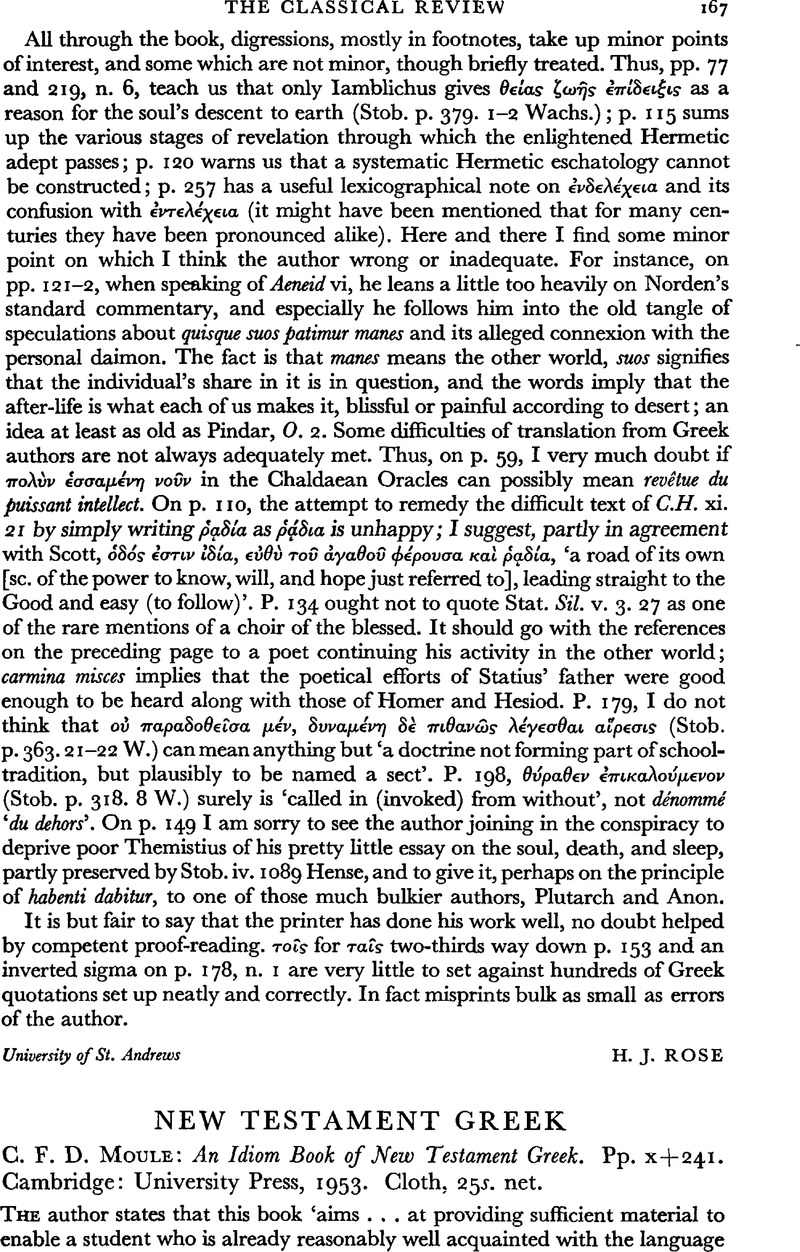No CrossRef data available.
Article contents
New Testament Greek - C. F. D. Moule: An Idiom Book of New Testament Greek. Pp. x+241. Cambridge: University Press, 1953. Cloth. 25s. net.
Published online by Cambridge University Press: 13 February 2009
Abstract

- Type
- Reviews
- Information
- Copyright
- Copyright © The Classical Association 1955
References
page 168 note 1 p. vii.
page 168 note 2 Mayser, E., Grammatik der griechische Papyri aus der Ptolemäerzeit, ii, Berlin, 1926Google Scholar.
page 168 note 3 2ème éd.; Paris, 1927.
page 168 note 4 Évangile selon S. Marc, Paris, 1911Google Scholar, S. Matth., 1923, S. Luc, 1921, S. Jean, 1925, Épître aux Romains, and numerous valuable remarks in Critique textuelle, 2ème éd. 1935.
page 168 note 5 Geschichte der griechischen Sprache, Berlin, 1928, p. 32Google Scholar.
page 169 note 1 The idiom of Koine became relatively uniform throughout the Near East but not entirely so and the language of at least portions of the N.T. is the most conspicuous exception. The Semitisms in Mk., Lk., Acts, and Rev. are more striking than their equivalents in other areas. Cf. Schwyzer, E., Griechische Grammatik (Handbuch der Altertumswissenschaft, ii. 1. 1), p. 126Google Scholar.
page 169 note 2 Wilamowitz-Moellendorff, op. cit., p. 32, n. 1
page 169 note 3 Thumb, A., Die griechische Sprache im Zeitalter des Hellenismus, Strassburg, 1901Google Scholar.
page 169 note 4 Op. cit.
page 169 note 5 Op. cit.
page 169 note 6 Jannaris, A. H., Historical Greek Grammar, London, 1897Google Scholar.
page 169 note 7 Nock, A. D., St. Paul, New York, 1938, pp. 27, 233 ff.Google Scholar; ‘The Vocabulary of the New Testament’, J.B.L. 52 (1933), p. 138.
page 169 note 8 Colwell, E. C., The Greek of the Fourth Gospel, Chicago, 1931Google Scholar.
page 169 note 9 Atkinson, F. C., The Greek Language, 2nd., London, 1933, pp. 264 ffGoogle Scholar.
page 169 note 10 Cadbury, H. J., The Making of Luke-Acts, London, 1927, pp. 113, 213Google Scholar; The Style and Literary Method of Luke (Harvard Theological Studies, vi. 1–2), Cambridge, Mass., 1919–20
page 169 note 11 Cf. Klostermann-Gressman, , Lukasevan-gelium; Tübingen, 1919, p. 558, ‘nicht Semitismus, sondern eine gute griechische Konstruktion’.Google Scholar
page 169 note 12 The linguistic facts about Ethiopic Enoch are stated in Charles, R. H., The Book of Enoch, Oxford, 1893, p. 128 (n. to 46. 2). His deductions from these are another matterGoogle Scholar.
page 169 note 13 Moore, G. F., Judaism, ii. 335Google Scholar; Volz, P., Die Eschatologie der jüdischen Gemeinde, 2te Aufl., Tübingen, 1934, p. 186Google Scholar; Dalman, G., The Words of Jesus (Eng. trans.), Edinburgh 1909, p. 234Google Scholar.




